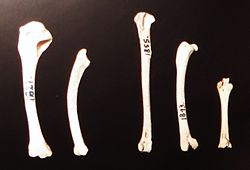| Canary Islands quail Temporal range: Late Pleistocene-Early Holocene | |
|---|---|
 | |
| Limb bones | |
| Scientific classification | |
| Kingdom: | Animalia |
| Phylum: | Chordata |
| Class: | Aves |
| Order: | Galliformes |
| Family: | Phasianidae |
| Genus: | Coturnix |
| Species: | C. gomerae |
| Binomial name | |
| Coturnix gomerae Jaume, McMinn & Alcover, 1993 | |
The Canary Islands quail (Coturnix gomerae) is an extinct quail species that once occurred on the island of La Gomera (Canary Islands, Spain).